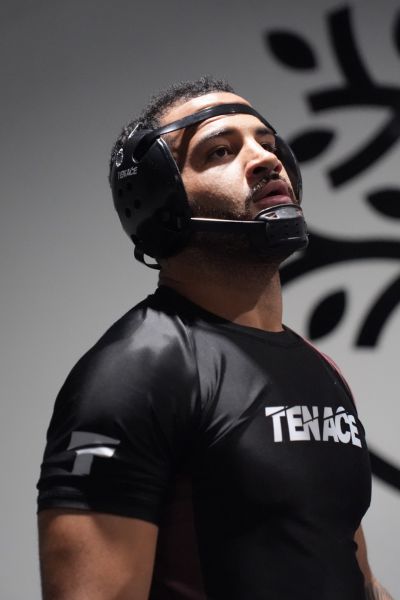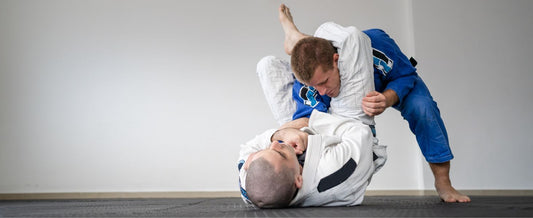
Turtle Position in BJJ and Grappling
How to survive, defend and attack from the turtle

These articles may also interest you:
- Knee Pads vs. No Knee Pads in BJJ, Grappling, etc. – Tenace
- Improve your grip with tape – Tenace
- 5 Techniques to Start Jiu-Jitsu – Tenace
Few positions generate as much discussion as the turtle position .
If you ask on a mat, you'll hear opposing answers: some see it as an excellent defensive tool, others as a death trap that leads straight to a strangulation or losing your back.
The truth is somewhere in between: the turtle can be your salvation or your doom . It all depends on how you use it, when you reach it, and what you do to get out.
In this article we will see:
- What exactly is the turtle position?
- When to use it and when to avoid it
- Real advantages and risks, both in BJJ and MMA or self-defense
- Most common mistakes made by practitioners
- How to defend it and transform it into an attack
- Recommended exercises and protections to train it safely
1. What is the turtle position?
The turtle is a defensive position where the fighter is placed on his knees and elbows , with his head down, his back rounded and his neck protected.
Its main objective is to avoid total control by the opponent and gain time to regain guard or stand up.
It is a very common reaction after a failed takedown, a partial escape from a submission, or a defense against a guard pass.
But here's the nuance: the turtle isn't a passive refuge . If you use it just to hold on, you're exposing yourself.
2. Advantages of the turtle
Although the turtle pose has a bad reputation among many practitioners, the truth is that it can be a very useful tool if you understand its purpose and apply it correctly. It's not about making it your favorite position, but rather knowing how to use it at the right times.
Avoid an immediate past guard
In BJJ competitions, the guard pass often awards points and, more importantly, puts your opponent in a dominant position. Actively adopting the turtle position, closing the gaps and protecting your neck, can prevent your opponent from completing the pass and give you precious seconds to reorganize your defense.
Option to transition to safe positions
From turtle, with good control of your opponent's hands and explosive movement, you can enter half guard, regain full guard, or even stand up with a single leg. This position, when properly trained, allows you to create quick transitions without being completely under control.
Greater mobility than being completely face down
In grappling, when you're pinned face down and your opponent controls your back and hips, your options are limited. The turtle, on the other hand, keeps your hips active and your knees as a base of support, allowing you to move and create angles for escape.
3. Real risks and disadvantages
Now, it is not a risk-free position .
In sport grappling, the turtle can become a trap if the opponent is skilled at attacks from that position:
Fast and effective chokeholds
Techniques such as the mata leão , the clock choke , or gi chokes from the back are very effective against someone who neglects turtle neck defense.
Arm locks and joint attacks
A common mistake is to leave your elbows separated from your knees; that small gap can be enough for your opponent to attack a kimura, armbar, or shoulder block.
Loss of back
If the opponent gains a side angle or lands a hook, the transition to the back is practically inevitable, leaving you in the worst possible position.
In MMA or self-defense , the risks increase:
-
Direct blows to the head, knees to the side and kicks if the situation allows.
-
Reduced visibility of the surroundings, which is critical if there is more than one aggressor.
4. Key principle: dynamism and weight control
The turtle only works if it's active . Standing still, waiting for your opponent to make a mistake, is an invitation for them to consolidate their control.
When you are below :
- Don't let your opponent stabilize his position : if you feel he's shifting his weight, start turning or shifting your base.
- Keep your elbows and knees close to close gaps and protect your neck.
- Use short, explosive movements to gain angles toward half guard or to get up.
When you're on top :
- Stay close to his back and shoulders so he can support your weight.
- Don't give him room to turn or get up .
- Tire him out by controlling your opponent's breathing with constant pressure.
5. Common mistakes wrestlers make
These are the most common mistakes that make the turtle position a high-risk position:
Total passivity
Using the turtle solely to hold without looking for transitions is a serious mistake. Every second that passes, the opponent fine-tunes their control and reduces your escape options.
Hollows in neck and elbows
Many submissions are successful not because the opponent is extremely fast, but because the defender leaves minimal space. The neck should always be protected with the chin, and the hands should control the opponent's wrists or forearms.
Forget the opponent's angle
If the attacker gains a 90-degree angle toward your side, the transition to the back or crucifix is almost certain. Therefore, it's key to turn toward the side where you have more control.
Confusing sporting turtle with real defense
In grappling or sport BJJ, the turtle can be relatively safe if you know the defenses. In self-defense or MMA, without striking training, it's extremely dangerous.

6. How to defend the turtle correctly
Getting out of the turtle isn't just a matter of holding and waiting: it's a game of precision, timing, and explosiveness. If you practice these exits regularly, you can turn a defensive position into an offensive opportunity.
Don't train the turtle solely as a defense. Dedicate part of your sparring sessions to starting the turtle and testing escapes under real pressure. This way, your reaction will be automatic in combat.
6.1 Recover half guard
One of the safest ways out is to turn towards your opponent, put a knee between his body and yours, and establish half guard.
- Technical keys : Keep your elbow and knee together to prevent your opponent from blocking you; use your opposite hand to control their wrist and create space.
- Advantage : Once in half guard, you drastically reduce the opponent's attack options and regain the ability to counterattack.
6.2 Getting up with a single leg
If you detect that your opponent doesn't have solid control over your hips, you can quickly rise up on one leg and hook his.
- Technical keys : first control your arms to avoid guillotines, then move one knee forward and stand up, keeping your head close to your side.
- Advantage : You regain your standing position, which in MMA or self-defense is pure gold.
6.3 Big turn to inverted guard or 50/50
More advanced, this technique requires good timing and flexibility. It involves rolling to the side opposite your opponent's grip, bringing your legs up to their waist.
- Technical keys : hook his arm or leg before the turn to drag him with you, protecting your neck.
- Advantage : You go from defending to entering an offensive guard with many attack options.
7. How to attack from the turtle (if you are on top)
If you find yourself on top of your opponent in turtle:
- Stay connected, with weight on your shoulders and hips.
- Attack with chokes like the clock choke or the rear naked choke after gaining the back.
- Use transitions to crucifix or side control if he opens too much.
8. Drills and exercises to improve your turtle
- Granby roll to change angle and escape.
- Rolls to guard with progressive resistance.
- Simulation of real attacks (with controlled blows if for MMA or self-defense).
- Time-limited workouts : Learn to keep your turtle active only as long as necessary.
9. Recommended protections for training without fear
The turtle especially punishes knees, elbows and neck .
If you train intensely, use:
- Knee pads to absorb impacts
- Elbow pads to protect from friction and pressure
- Strengthening and caring for your neck with exercises or light protection
At Tenace we have protections designed for grapplers who train hard:
✅ Knee pads with stabilizers for impact and torsion
✅ Durable and breathable compression elbow pads
✅ Earmuffs to avoid cauliflower, even during intense drills
The turtle position is not a place to “wait for the storm to pass.”
Used well, it is a bridge to a more advantageous position or a counterattack.
Misused, it's a gift to your opponent.
Train it, understand when to use it, and combine it with self-defense and MMA strategies if you're looking for a more realistic approach.
Remember: in grappling it's all about timing and control .
💬 And you, do you use the turtle in your fights or do you avoid it?
Leave it in the comments and tell us about your experience.
🎁 Reader bonus : Use code T-10 and get a 10% discount on any product on our website to protect your joints while you work out.





